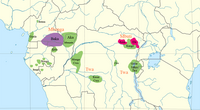
Photo from wikipedia
Anopheles funestus s.s. is a primary vector of malaria in sub-Saharan Africa. Despite its important role in human Plasmodium transmission, evolutionary history, genetic diversity, and population structure of An. funestus… Click to show full abstract
Anopheles funestus s.s. is a primary vector of malaria in sub-Saharan Africa. Despite its important role in human Plasmodium transmission, evolutionary history, genetic diversity, and population structure of An. funestus in southern and central Africa remains understudied. We deep sequenced, assembled, and annotated the complete mitochondrial genome of An. funestus s.s. for the first time, providing a foundation for further genetic research of this important malaria vector species. We further analyzed the complete mitochondrial genomes of 43 An. funestus s.s. from three sites in Zambia, Democratic Republic of the Congo, and Tanzania. From these 43 mitogenomes we identified 41 unique haplotypes that comprised 567 polymorphic sites. Bayesian phylogenetic reconstruction confirmed the co-existence of two highly divergent An. funestus maternal lineages, herein defined as lineages I and II, in Zambia and Tanzania. The estimated coalescence time of these two mitochondrial lineages is ~500,000 years ago (95% HPD 426,000–594,000 years ago) with subsequent independent diversification. Haplotype network and phylogenetic analysis revealed two major clusters within lineage I, and genetic relatedness of samples with deep branching in lineage II. At this time, data suggest that the lineages are partially sympatric. This study illustrates that accurate retrieval of full mitogenomes of Anopheles vectors enables fine-resolution studies of intraspecies genetic relationships, population differentiation, and demographic history. Further investigations on whether An. funestus mitochondrial lineages represent biologically meaningful populations and their potential implications for malaria vector control are warranted.
Journal Title: Scientific Reports
Year Published: 2018
Link to full text (if available)
Share on Social Media: Sign Up to like & get
recommendations!